2. 西安交通大学医学部公共卫生学院, 陕西 西安 710061;
3. 西安交通大学医学部护理学院, 陕西 西安 710061;
4. 西安交通大学第一附属医院护理部, 陕西 西安 710061
2. School of Public Health, Health Science Center, Xi'an Jiaotong University, Xi'an 710061, China;
3. School of Nursing, Health Science Center, Xi'an Jiaotong University, Xi'an 710061, China;
4. Department of Nursing, The First Affiliated Hospital, Xi'an Jiaotong University, Xi'an 710061, China
静脉输液治疗是护理领域常见操作,导管相关血流感染(catheter-related bloodstream infection,CRBSI)是静脉输液治疗过程一种严重的并发症,CRBSI是指血管内置入导管或拔出导管48 h内患者出现菌血症或真菌血症,并伴发热(>38℃)、寒战或低血压等感染表现,且除血管导管感染外无其他明确感染源的感染。实验室微生物学检查显示外周静脉血培养细菌或真菌阳性,或从导管段和外周血培养出相同种类、相同药敏结果的致病菌,也是医院菌血症最常见的原因。CRBSI治疗成本为32 000~69 332美元[1-5]。
不同输液工具导致CRBSI发生率不用,中等长度导管又称中线导管(midline catheter,MC),导管长度20~30 cm,从肘窝处上下两横指常规穿刺或采用超声引导技术从上臂置入贵要静脉、头静脉或肱静脉内,导管尖端位于腋静脉胸段或可到达锁骨下静脉。MC CRBSI发生率为0~0.9%[6-10]。经外周静脉穿刺中心静脉置管(peripherally inserted central catheter,PICC)是一种经过外周静脉如手臂静脉或隐静脉置入,尖端到达上腔静脉或右心房的中心静脉导管输液工具,PICC可用于长期化学治疗药物和延长抗菌药物治疗,全肠外营养或不适宜外周静脉输注药物的输注。PICC CRBSI发生率为0.13%~7.3%[11-16]。由于MC前期研究关注度低,近年研究逐渐增多,国内外目前尚无探究MC与PICC静脉输液治疗中CRBSI发生率的系统评价。本研究通过系统回顾与Meta分析,探究MC与PICC静脉输液治疗中CRBSI发生率的差异,以期为临床静脉输液治疗过程防治CRBSI提供参考。
1 资料与方法 1.1 检索策略根据PRISMA(Prefered reporting item for systematic reviews and Meta-analyses)系统回顾和荟萃分析报告指南进行研究[17],计算机检索Web of Science、PubMed、Scopus、Embase、Cochrane Library、ProQuest、中国知网(China National Knowledge Infrastructure,CNKI)、万方数据库(WanFang)、维普数据库(VIP)、中国生物医学文献数据库(CBM)中的文献,采用主题词高级检索策略,使用同义词扩展功能,中文检索词为:(1)经外周穿刺中心静脉导管、经外周静脉置入中心静脉导管、PICC导管;(2)中等长度导管、中长导管、中线导管;(3)血流感染、导管相关性血流感染、菌血症、败血症、脓毒血症;英文检索词:(1)midline catheter*、midline venous catheter*、midline peripheral catheter*、medium-term intravenous access*;(2)peripherally inserted central catheter*、percutaneous indwelling central catheter*、peripherally inserted central venous catheter*、PICC line*、PICC*;(3)bacteremia、bacteriemia、septicemia、sepsis、bloodstream infection*。检索时间均为建库至2020年1月。以PubMed为例,具体检索策略见图 1。
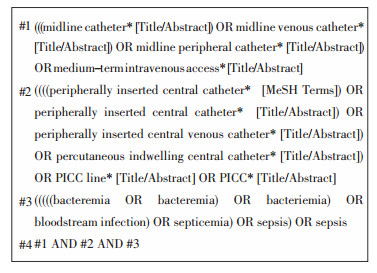 |
| 图 1 MC与PICC静脉输液治疗CRBSI发生率Meta分析的PubMed检索策略 Figure 1 PubMed search strategy for Meta-analysis on incidence of CRBSI during intravenous infusion therapy through MC and PICC |
纳入标准:(1)研究类型,MC与PICC关于CRBSI并发症相关试验性或观察性研究。(2)研究对象,患者使用MC或PICC进行静脉输液治疗发生CRBSI并发症状况的观察性研究,MC与PICC静脉治疗CRBSI并发症相关干预性试验性研究。(3)暴露因素/干预措施为患者暴露MC与PICC静脉治疗工具。对患者进行MC或PICC治疗,不同治疗工具互为干预对照。(4)结局指标,患者是否出现CRBSI,CRBSI被定义为MC或PICC导管引起的菌血症或真菌血症等,血培养阳性,排除或无其他解释。排除标准:(1)个案报道、综述、评述等;(2)非人体研究文献;(3)二次研究;(4)研究对象<10例;(5)重复发表的文献及其他可疑重复报告文献;(6)报告数据不完整,无法获取相关数据的文献。由两名研究者分别独立检索,先浏览标题与摘要初筛,阅读全文确定纳入与排除文献。如果遇到分歧,与第三方研究人员协商达成一致。
1.3 文献质量评价由于纳入研究中有试验性研究与观察性研究,由两名研究者独立采用Downs and Black[18]提出的文献质量评价清单对文献进行质量评价。清单评估包括报告、外部效度、内部效度、偏倚、统计分析5个维度27个条目共32分。文献质量按照得分依次分为优秀(≥26分)、良好(20~25分)、中等(15~19分)、差(≤14分)四个等级[19]。
1.4 文献筛选及资料提取数据提取采用Cochrane协作网提供的模板[20],由两名研究人员独立提取数据,并由第三名研究人员核对,建立数据库。资料提取内容包括:文献第一作者及发表时间、研究方法、研究国家、研究时间、研究人群特征、MC与PICC数量及CRBSI发生例数。
1.5 统计学分析应用RevMan 5.3软件进行Meta分析,计数资料用相对危险度(RR)为效应指标,计量资料采用均数差(MD)为效应指标,各效应量均给出其点估计值和95%置信区间(CI)。纳入研究结果间的异质性分析采用I2评估,当I2>50%时,显示存在明显的异质性,则采用随机效应模型;当I2≤50%时,考虑无异质性,采用固定效应模型。对有明显的临床异质性的研究进行亚组分析或敏感性分析,或只进行描述性分析。敏感性分析采用剔除法,检查统计结果是否显著改变。组间对比采用χ2检验,P≤0.05为差异有统计学意义。Meta分析的检验水准为α=0.05。发表偏倚通过漏斗图检测,不对称性越大提示偏倚程度越大。
2 结果 2.1 文献检索结果初步检索共获得347篇文献,排除重复文献,阅读题目和摘要初筛,阅读全文,最终纳入15篇文献[21-35],其中英文11篇[21-23, 28-35],中文4篇[24-27]。文献筛选流程及结果见图 2。
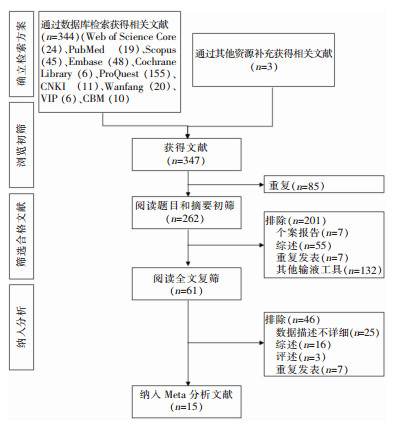 |
| 图 2 MC与PICC静脉输液治疗CRBSI发生率Meta分析的文献筛选流程及结果 Figure 2 Literature screening process and result of Meta-analysis on incidence of CRBSI during intravenous infusion therapy through MC and PICC |
纳入15篇文献,其中4篇来自美国[21, 28, 30, 34],5篇来自中国[23-27],3篇来自英国[22, 33, 35],澳大利亚[31]、加拿大[32]、捷克[29]各1篇。2篇文献为会议摘要[32, 35]。共纳入患者34 235例,其中MC组7 392例,PICC组26 843例。其他3篇数据报告不完整文献也进行了评估[36-38]。见表 1。
| 表 1 MC与PICC静脉输液治疗CRBSI发生率Meta分析纳入文献的基本特征 Table 1 Basic characteristics of included literatures for Meta-analysis on incidence of CRBSI during intravenous infusion therapy through MC and PICC |
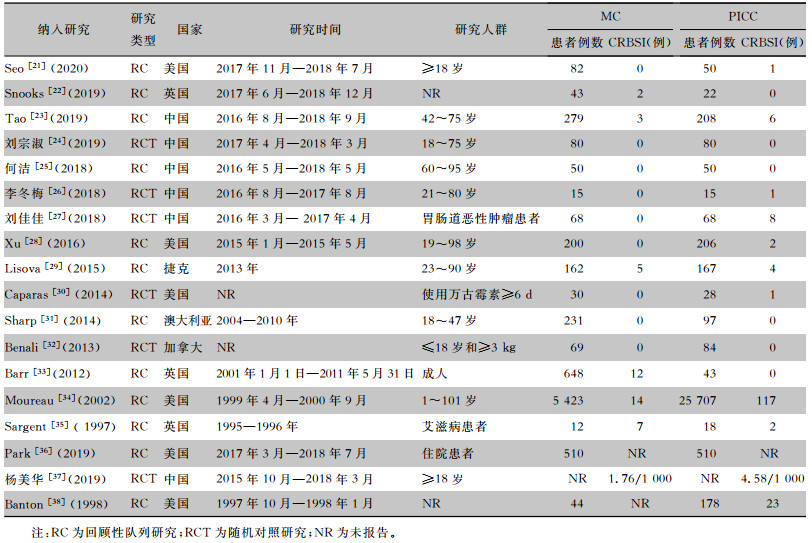
|
纳入的15篇文献中,5篇研究质量良好[21, 23, 28, 30, 31],5篇研究质量中等[24, 26-27, 33-34],5篇研究质量差[22, 25, 29, 32, 35]。见表 2。
| 表 2 MC与PICC静脉输液治疗CRBSI发生率Meta分析纳入文献的质量评价结果 Table 2 Quality evaluation result of included literatures for Meta-analysis on incidence of CRBSI during intravenous infusion therapy through MC and PICC |
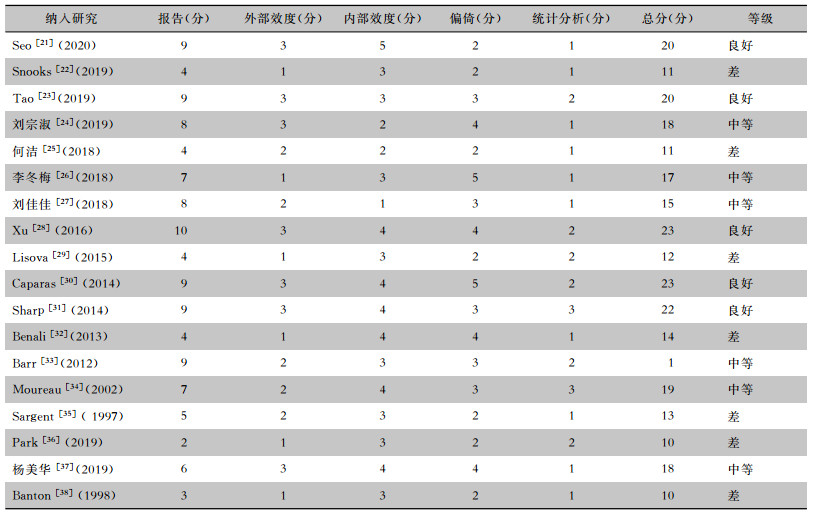
|
对15篇研究中的34 235例患者进行Meta分析,结果显示MC组CRBSI发生率0.58%(43/7 392),PICC组CRBSI发生率0.53%(142/26 843),各研究间异质性低(I2=38%),采用固定效应模型,Meta分析显示MC组CRBSI发生率低于PICC组,差异有统计学意义[RR=0.63,95%CI(0.43,0.93),P=0.02]。见图 3。根据研究质量不同,剔除5篇质量差的研究[22, 25, 29, 32, 35],各研究间异质性显著性降低(I2=0),采用固定效应模型,Meta分析显示MC组CRBSI发生率低于PICC组,差异有统计学意义[RR=0.46,95%CI(0.29,0.73),P<0.001]。
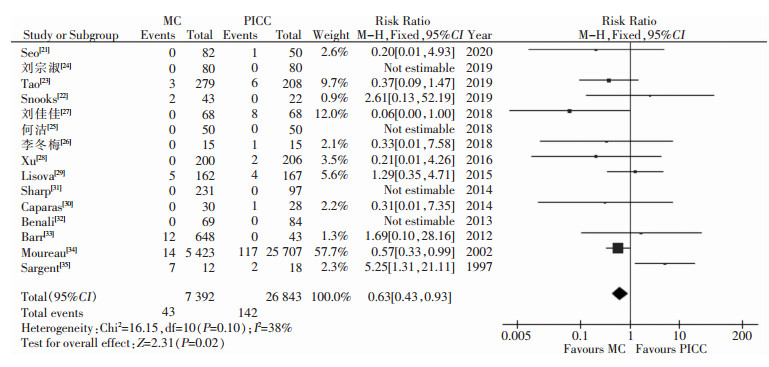 |
| 图 3 MC组与PICC组发生CRBSI风险Meta分析结果 Figure 3 Meta-analysis result of occurrence risk of CRBSI in MC group and PICC group |
根据研究对象来源国家不同,将研究分为中国[23-27]、美国[21, 28, 30, 34]、英国[22, 33, 35]、其他国家[29, 31-32]亚组,其中中国亚组各研究间无异质性(I2=0),Meta分析显示MC组CRBSI发生率低于PICC组,差异有统计学意义[RR=0.21,95%CI(0.07,0.64),P=0.006];美国亚组各研究间无异质性(I2=0),Meta分析显示MC组CRBSI发生率低于PICC组,差异有统计学意义[RR=0.53,95%CI(0.31,0.89),P=0.02];英国亚组各研究间无异质性(I2=0),Meta分析显示MC组CRBSI发生率高于PICC组,差异有统计学意义[RR=3.67,95%CI(1.18,11.37),P=0.02];其他国家亚组Meta分析显示MC组CRBSI发生率与PICC组差异无统计学意义[RR=1.29,95%CI(0.35,4.71),P=0.70]。见图 4。
 |
| 图 4 MC组与PICC组发生CRBSI风险各国亚组Meta分析结果 Figure 4 Meta-analysis result of occurrence risk of CRBSI in MC group and PICC group in each country subgroup |
根据研究对象年龄不同,将研究分为成人研究[21, 23-26, 28-29, 31, 33]和其他亚组,其他亚组包括儿童[32]、儿童和成人[34]以及未报告研究对象年龄的研究[22, 27, 30, 35]。其中成人亚组各研究间无异质性(I2=0),Meta分析显示MC组CRBSI发生率与PICC组差异无统计学意义[RR=0.60,95%CI(0.29,1.28),P=0.19];其他亚组各研究间有中度异质性(I2=69%),提示各研究间异质性较大,Meta分析显示MC组CRBSI发生率与PICC组差异无统计学意义[RR=0.64,95%CI(0.41,1.01),P=0.06]。见图 5。
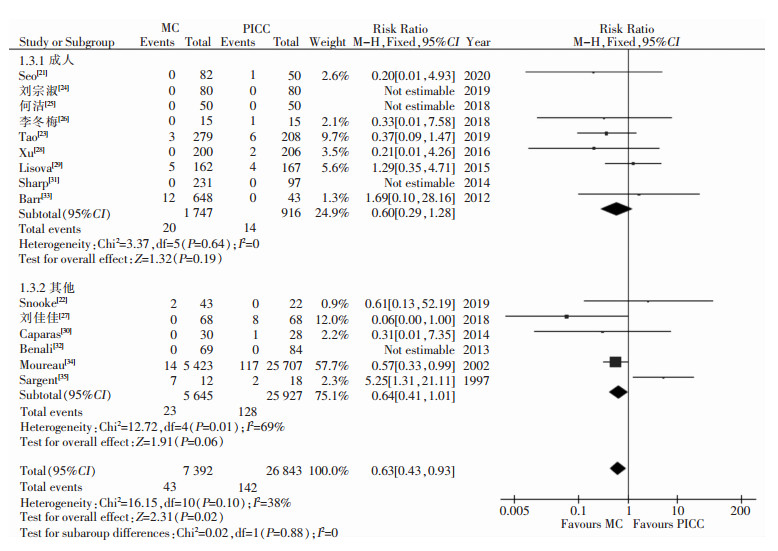 |
| 图 5 MC与PICC发生CRBSI风险各年龄亚组Meta分析结果 Figure 5 Meta-analysis result of occurrence risk of CRBSI in MC group and PICC group in each age subgroup |
根据研究类型不同,将研究分为随机对照研究(RCT)亚组[24, 26-27, 30, 32]和回顾性队列研究(RC)亚组[21-23, 25, 28-29, 31, 33-35],其中RCT亚组各研究间无异质性(I2=0),Meta分析显示MC组CRBSI发生率低于PICC组,差异有统计学意义[RR=0.12,95%CI(0.02,0.66),P=0.01];RC亚组各研究间有低异质性(I2=46%),Meta分析显示MC组CRBSI发生率与PICC组差异无统计学意义[RR=0.73,95%CI(0.48,1.10),P=0.13]。见图 6。
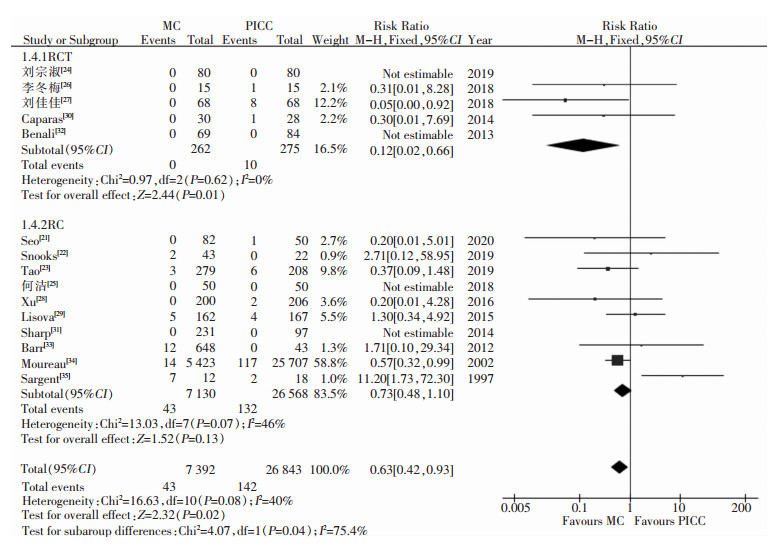 |
| 图 6 MC与PICC发生CRBSI风险不同研究类型Meta分析结果 Figure 6 Meta-analysis result of occurrence risk of CRBSI in MC group and PICC group in different study subgroup |
对纳入的15篇研究逐一进行剔除,敏感性分析结果表明,任意排除其中的一篇研究后,合并OR值为0.61,95%CI为0.41~91,与总合并效应值相似,提示本研究结果稳定可信。见图 7。在质量良好及质量中等研究之间,逐一剔除各项研究,研究结果也无显著性改变。
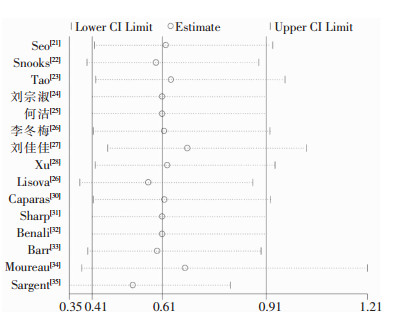 |
| 图 7 各研究MC组与PICC组发生CRBSI敏感性分析的结果 Figure 7 Sensitivity analysis result of occurrence of CRBSI in MC group and PICC group in each study subgroup |
发表偏倚检测中,漏斗图对称性良好,可认为无明显发表偏倚。部分研究处于漏斗图底端,提示部分研究质量较差。见图 8。
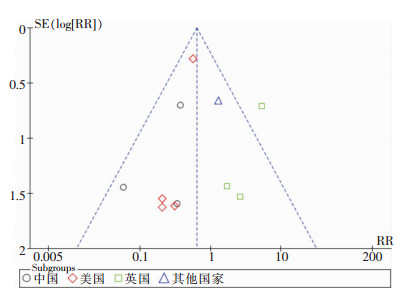 |
| 图 8 MC与PICC发生CRBSI风险漏斗图 Figure 8 Funnel plots of occurrence risk of CRBSI due to MC and PICC |
静脉输液CRBSI并发症是一种严重的并发症,不仅延长患者住院时间,增加住院成本,甚至威胁患者的生命安全[39-41]。不同的输液工具引起CRBSI发生率不同,PICC作为一种长期使用中心静脉的输液通路工具,经过多年实践,临床治疗技术已日趋完善,但其造成CRBSI高是一个不容忽视的问题[41-43],MC是近年逐渐新兴的一种静脉输液治疗工具,已在临床广泛使用。MC与PICC在静脉输液中均可不同程度发生CRBSI,但二者发生CRBSI风险各有不同,前期诸多研究对于MC与PICC发生CRBSI风险仍众说纷纭,本研究通过全面检索、系统回顾,采用Meta分析方法探究MC与PICC发生CRBSI风险,以期为后续静脉输液治疗选择合适输液工具提供依据。
本研究结果显示,MC组CRBSI发生率低于PICC组(P=0.02);剔除质量差的研究后,Meta分析结果仍显示MC组CRBSI发生率低于PICC组(P<0.001)。当分别剔除刘佳佳等[27]和Moureau等[34]研究,总体研究结果发生转变,然而在质量良好及质量中等研究之间,剔除各项研究,研究结果未发生改变,提示该研究结论MC组CRBSI发生率低于PICC组是稳定可靠的,与相关研究[36-37]结论一致。在亚组分析中来自中国的研究与来自美国的研究结论一致,证实MC组CRBSI发生率低于PICC组,然而来自英国的结论与此相反,可能与纳入来自英国的3篇研究质量欠佳(2篇质量差[22, 35],1篇质量中等[33])有关。成人研究亚组Meta分析显示,MC组CRBSI发生率与PICC组差异无统计学意义(P=0.19),且逐一剔除文献或剔除质量差的文献,研究结论未发生变化,但在其他亚组研究中,有4篇研究未报告研究对象的年龄[22, 27, 30, 35],是否对成人研究亚组有影响仍不可知,提示后期研究数据报告完整的重要性。只有1项儿童研究评价MC组与PICC组CRBSI风险[32],然而该项研究质量差,且两组均未发生CRBSI,对于儿童使用MC与PICC发生CRBSI风险评价无法参照,提示后期需更多关于儿童MC组与PICC组CRBSI风险性评价的研究。
敏感性分析过程中,总体各研究间稳定性一般,剔除少量研究,研究结论发生变化,但是质量良好和中等研究间稳定性好。根据漏斗图提示纳入研究无明显发表偏倚,但部分研究质量差,有待高质量研究的出现。
本文局限性在于:(1)纳入研究总体研究质量低,高质量研究少;(2)存在部分研究没有被检索到的可能,纳入研究均为发表的中英文文献,可能会有文献收录不全;(3)各研究间存在一定的统计学异质性。尽管如此,本研究仍是该领域首次对MC与PICC发生CRBSI风险进行系统评价与Meta分析。
综上所述,静脉输液治疗过程中MC组CRBSI发生率低于PICC组,在同等条件下可考虑优先选择MC为患者进行静脉输液治疗。今后仍需更多高质量探究MC与PICC发生CRBSI风险,以及儿童研究进一步评估MC与PICC发生CRBSI的风险。
| [1] |
Goudie A, Dynan L, Brady PW, et al. Attributable cost and length of stay for central line-associated bloodstream infections[J]. Pediatrics, 2014, 133(6): e1525-e1532. DOI:10.1542/peds.2013-3795 |
| [2] |
Wilson MZ, Rafferty C, Deeter D, et al. Attributable costs of central line-associated bloodstream infections in a pediatric hematology/oncology population[J]. Am J Infect Control, 2014, 42(11): 1157-1160. DOI:10.1016/j.ajic.2014.07.025 |
| [3] |
Kaye KS, Marchaim D, Chen TY, et al. Effect of nosocomial bloodstream infections on mortality, length of stay, and hospital costs in older adults[J]. J Am Geriatr Soc, 2014, 62(2): 306-311. DOI:10.1111/jgs.12634 |
| [4] |
Zimlichman E, Henderson D, Tamir O, et al. Health care-associated infections: a Meta-analysis of costs and financial impact on the US health care system[J]. JAMA Intern Med, 2013, 173(22): 2039-2046. DOI:10.1001/jamainternmed.2013.9763 |
| [5] |
Stevens V, Geiger K, Concannon C, et al. Inpatient costs, mortality and 30-day re-admission in patients with central-line-associated bloodstream infections[J]. Clin Microbiol Infect, 2014, 20(5): O318-O324. DOI:10.1111/1469-0691.12407 |
| [6] |
Chopra V, Kaatz S, Swaminathan L, et al. Variation in use and outcomes related to midline catheters: results from a multicentre pilot study[J]. BMJ Qual Saf, 2019, 28(9): 714-720. DOI:10.1136/bmjqs-2018-008554 |
| [7] |
Mushtaq A, Navalkele B, Kaur M, et al. Comparison of complications in midlines versus central venous catheters: are midlines safer than central venous lines?[J]. Am J Infect Control, 2018, 46(7): 788-792. DOI:10.1016/j.ajic.2018.01.006 |
| [8] |
Rotta SA, Laird J, Crombie RE, et al. Use of midline catheters in burn patients decreases central line use and CLABSI rates[J]. J Burn Care Res, 2015, 36: S122. |
| [9] |
Cummings M, Hearse N, McCutcheon H, et al. Improving antibiotic treatment outcomes through the implementation of a midline: piloting a change in practice for cystic fibrosis patients[J]. J Vasc Nurs, 2011, 29(1): 11-15. DOI:10.1016/j.jvn.2010.11.005 |
| [10] |
Maki DG, Kluger DM, Crnich CJ. The risk of bloodstream infection in adults with different intravascular devices: a syste-matic review of 200 published prospective studies[J]. Mayo Clin Proc, 2006, 81(9): 1159-1171. DOI:10.4065/81.9.1159 |
| [11] |
Kagan E, Salgado CD, Banks AL, et al. Peripherally inserted central catheter-associated bloodstream infection: risk factors and the role of antibiotic-impregnated catheters for prevention[J]. Am J Infect Control, 2019, 47(2): 191-195. DOI:10.1016/j.ajic.2018.07.006 |
| [12] |
Poletti F, Coccino C, Monolo D, et al. Efficacy and safety of peripherally inserted central venous catheters in acute cardiac care management[J]. J Vasc Access, 2018, 19(5): 455-460. DOI:10.1177/1129729818758984 |
| [13] |
Bhargava V, George L, Malloy M, et al. The role of a single dose of vancomycin in reducing clinical sepsis in premature infants prior to removal of peripherally inserted central catheter: a retrospective study[J]. Am J Perinatol, 2018, 35(10): 990-993. DOI:10.1055/s-0038-1632391 |
| [14] |
Puspos J. Tri-bundles for PICC insertion: prevention of PICC related complications[J]. JAVA, 2016, 21(4): 261. |
| [15] |
Liu ZP, Chen JQ, Zan LP, et al. Exploring the risk factors of thrombosis and bloodstream infections in peripherally inserted central catheter (PICC) patients[J]. J Biomater Tissue Eng, 2019, 9(7): 929-934. DOI:10.1166/jbt.2019.2095 |
| [16] |
Bouzad C, Duron S, Bousquet A, et al. Peripherally inserted central catheter-related infections in a cohort of hospitalized adult patients[J]. Cardiovasc Intervent Radiol, 2016, 39(3): 385-393. DOI:10.1007/s00270-015-1182-4 |
| [17] |
Moher D, Liberati A, Tetzlaff J, et al. Preferred reporting items for systematic reviews and Meta-analyses: the PRISMA statement[J]. PLoS Med, 2009, 6(7): e1000097. DOI:10.1371/journal.pmed.1000097 |
| [18] |
Downs SH, Black N. The feasibility of creating a checklist for the assessment of the methodological quality both of rando-mised and non-randomised studies of health care interventions[J]. J Epidemiol Community Health, 1998, 52(6): 377-384. DOI:10.1136/jech.52.6.377 |
| [19] |
Ray-Barruel G, Xu H, Marsh N, et al. Effectiveness of insertion and maintenance bundles in preventing peripheral intravenous catheter-related complications and bloodstream infection in hospital patients: a systematic review[J]. Infect Dis Health, 2019, 24(3): 152-168. DOI:10.1016/j.idh.2019.03.001 |
| [20] |
Higgins L, Thomas J, Chandler J, et al. Cochrane handbook for systematic reviews of interventions version 6.1[EB/OL]. [2020-03-28]. https://training.cochrane.org/handbook/current.
|
| [21] |
Seo H, Altshuler D, Dubrovskaya Y, et al. The safety of midline catheters for intravenous therapy at a large academic medical center[J]. Ann Pharmacother, 2020, 54(3): 232-238. DOI:10.1177/1060028019878794 |
| [22] |
Snooks R, Catton T, Harris M, et al. Central venous, peripherally inserted central and midline catheters on neurointensive care: a retrospective audit[J]. J Neurosurg Anesthesiol, 2019, 31(1): 92-93. |
| [23] |
Tao FY, Wang XH, Liu JM, et al. Perioperative application of midline catheter and PICC in patients with gastrointestinal tumors[J]. J BUON, 2019, 24(6): 2546-2552. |
| [24] |
刘宗淑, 宋秀荣, 孔林芳, 等. 超声引导下改良塞丁格技术植入改良外周静脉中长导管的临床应用效果[J]. 中外医学研究, 2019, 17(35): 173-175. |
| [25] |
何洁, 曾令琼. 老年住院患者静脉中长导管临床相关并发症的调查[J]. 健康大视野, 2018(19): 26. |
| [26] |
李冬梅, 陈兰兰, 韩玉婷, 等. 中等长度导管在神经外科病人静脉输液中的应用[J]. 护理研究, 2018, 32(24): 3966-3968. DOI:10.12102/j.issn.1009-6493.2018.24.049 |
| [27] |
刘佳佳, 张娟, 谭蕾. 改良型中等长度导管与PICC在胃肠道肿瘤患者围手术期中的应用比较[J]. 护理实践与研究, 2018, 15(7): 143-145. |
| [28] |
Xu TY, Kingsley L, DiNucci S, et al. Safety and utilization of peripherally inserted central catheters versus midline catheters at a large academic medical center[J]. Am J Infect Control, 2016, 44(12): 1458-1461. DOI:10.1016/j.ajic.2016.09.010 |
| [29] |
Lisova K, Paulinova V, Zemanova K, et al. Experiences of the first PICC team in the Czech Republic[J]. Br J Nurs, 2015, 24(2): S4, S6, S10. |
| [30] |
Caparas JV, Hu JP. Safe administration of vancomycin through a novel midline catheter: a randomized, prospective clinical trial[J]. J Vasc Access, 2014, 15(4): 251-256. DOI:10.5301/jva.5000220 |
| [31] |
Sharp R, Esterman A, McCutcheon H, et al. The safety and efficacy of midlines compared to peripherally inserted central catheters for adult cystic fibrosis patients: a retrospective, observational study[J]. Int J Nurs Stud, 2014, 51(5): 694-702. DOI:10.1016/j.ijnurstu.2013.09.002 |
| [32] |
Benali S, Rypens F, Lacroix J, et al. Midline catheters versus peripherally inserted central catheters(PICC) in children: a randomized clinical trial[J]. Pediatr Radiol, 2013, 43(S3): S541. |
| [33] |
Barr DA, Semple L, Seaton RA. Self-administration of outpatient parenteral antibiotic therapy and risk of catheter-related adverse events: a retrospective cohort study[J]. Eur J Clin Microbiol Infect Dis, 2012, 31(10): 2611-2619. DOI:10.1007/s10096-012-1604-z |
| [34] |
Moureau N, Poole S, Murdock MA, et al. Central venous catheters in home infusion care: outcomes analysis in 50, 470 patients[J]. J Vasc Interv Radiol, 2002, 13(10): 1009-1016. DOI:10.1016/S1051-0443(07)61865-X |
| [35] |
Sargent J, Nixon E. I.v. access options for AIDS patients with cytomegalovirus disease[J]. Br J Nurs, 1997, 6(10): 543-546, 548, 550-553. DOI:10.12968/bjon.1997.6.10.543 |
| [36] |
Park T, Eklund J, Riesenberg J, et al. Does implementation of an effective midline catheter program for vascular access in a large academic hospital decrease rates of bloodstream infections?[J]. J Vasc Interv Radiol, 2019, 30(3): S159. |
| [37] |
杨美华, 袁顺琼, 甘秀妮, 等. 中长导管在急性胰腺炎患者静脉输液治疗中的临床效果观察[J]. 检验医学与临床, 2019, 16(6): 729-731. |
| [38] |
Banton J, Leahy-Gross K. Assessing catheter performance: four years of tracking patient outcomes of midline, midclavicular and PICC line program[J]. J Vasc Access Devices, 1998, 3(3): 19-25. DOI:10.2309/108300898775992923 |
| [39] |
Bessis S, Cassir N, Meddeb L, et al. Early mortality attributable to PICC-lines in 4 public hospitals of Marseille from 2010 to 2016(revised V3)[J]. Medicine (Baltimore), 2020, 99(1): e18494. DOI:10.1097/MD.0000000000018494 |
| [40] |
Velissaris D, Karamouzos V, Lagadinou M, et al. Peripheral inserted central catheter use and related infections in clinical practice: a literature update[J]. J Clin Med Res, 2019, 11(4): 237-246. DOI:10.14740/jocmr3757 |
| [41] |
罗小强, 龚雅利, 张成, 等. 159例烧伤重症监护病房导管相关性血流感染患者病原菌分布及耐药性分析[J]. 中华烧伤杂志, 2020, 36(1): 24-31. |
| [42] |
Silva JT, Lagares-Velasco A, Fernández-Ruiz M, et al. Peripherally inserted central venous catheter placed and maintained by a dedicated nursing team for the administration of antimicrobial therapy vs. another type of catheter: a retrospective case-control study[J]. Enferm Infecc Microbiol Clin, 2020, 38(9): 425-430. DOI:10.1016/j.eimc.2020.01.005 |
| [43] |
Lee JH, Kim MU, Kim ET, et al. Prevalence and predictors of peripherally inserted central venous catheter associated bloodstream infections in cancer patients: a multicentre cohort study[J]. Medicine (Baltimore), 2020, 99(6): e19056. DOI:10.1097/MD.0000000000019056 |




